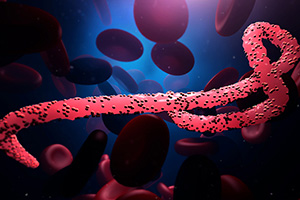FULL STORY
A Major Step in Developing an Effective Ebola Therapy
August 9, 2018—(BRONX, NY)—In a paper published online on August 9 in Cell, 48 collaborating authors from 23 institutions and companies, including Albert Einstein College of Medicine, made significant strides towards understanding how monoclonal antibodies work to defeat Ebola virus. The two new Ebola outbreaks in the Democratic Republic of Congo this year, including one ongoing, highlight the need for effective treatments and preventive measures against the deadly microbe.

Kartik Chandran, Ph.D., and Jonathan Lai, Ph.D.The authors belong to the Viral Hemorrhagic Fever Immunotherapeutic Consortium (VIC), an international group of virologists who are working to stop or quell future Ebola outbreaks. Einstein’s VIC members, Kartik Chandran, Ph.D. and Jonathan R. Lai, Ph.D., contributed to the research described in the Cell paper. Dr. Chandran, a senior author on the paper, is professor of microbiology & immunology and the Harold and Muriel Block Faculty Scholar in Virology at Einstein. Dr. Lai is professor of biochemistry at Einstein.
From 16 labs around the world, the VIC researchers gathered 171 monoclonal antibodies that were known to target various sites on Ebola virus. They then evaluated those antibodies under identical assay conditions to determine which antibodies work best against Ebola virus and why. The goal was not to develop an Ebola vaccine to prevent infection but rather to identify the most effective antibodies and understand why they are effective in protecting mice from infection. Such antibodies could potentially be combined into a therapeutic “cocktail” to be administered to people already infected with Ebola virus.
The researchers conducted three in vitro assays on each of the antibodies to determine its ability to neutralize Ebola virus, i.e., to disable or weaken it. (To understand how the antibodies neutralize Ebola, the researchers also determined exactly where on the virus these antibodies were binding.) In addition, they assessed each antibody to see if it could protect mice inoculated with Ebola virus.
 Typically, an antibody’s ability to neutralize a virus determines whether scientists consider that antibody a therapeutic candidate. But in this study, researchers also looked at correlations between each antibody’s in vitro neutralization of Ebola and its ability to protect Ebola-infected mice. They found that 12 antibodies had little or no neutralizing activity against Ebola virus but nevertheless helped protect mice. The researchers speculate that these antibodies (as well as several of the neutralizing antibodies) fight infection by harnessing an animal’s immune system, thereby yielding a better immune response to the virus. This new information could lead to strategies for selecting therapeutic antibodies against Ebola and a related deadly virus called Marburg virus.
Typically, an antibody’s ability to neutralize a virus determines whether scientists consider that antibody a therapeutic candidate. But in this study, researchers also looked at correlations between each antibody’s in vitro neutralization of Ebola and its ability to protect Ebola-infected mice. They found that 12 antibodies had little or no neutralizing activity against Ebola virus but nevertheless helped protect mice. The researchers speculate that these antibodies (as well as several of the neutralizing antibodies) fight infection by harnessing an animal’s immune system, thereby yielding a better immune response to the virus. This new information could lead to strategies for selecting therapeutic antibodies against Ebola and a related deadly virus called Marburg virus.
In ongoing research, the Chandran and Lai labs are developing antibody cocktails that can broadly protect against Ebola and Marburg viruses as well as other emerging viruses that cause severe disease in humans. Results from the VIC are bolstering these efforts.
The major support for this project was U19 AI109762, a Centers of Excellence in Translational Research Award of the NIAID.
Other Top Stories
9/11 World Trade Center Exposure Linked to Heart Disease Among NYC Firefighters
On Becoming a Physician: New Einstein Students Receive White Coats and Stethoscopes
Novel Therapy for Acute Migraine Shows Promise in Phase 3 Clinical Trial
First Complete Wiring Diagram of an Animal's Nervous System
Multimillion Dollar NIH Grant to Help Reduce Opioid Use & Get Care to People Who Need It
NIH Grant Funds $23 Million Study of Diseases Affecting People Living with HIV
New TAILORx Data Guides Adjuvant Therapy in Younger Breast Cancer Patients
Einstein Celebrates Its 61st Commencement
Bolstering Biopsies: Testing Patients' Individual Cells to Guide Treatment



Tablet Blog